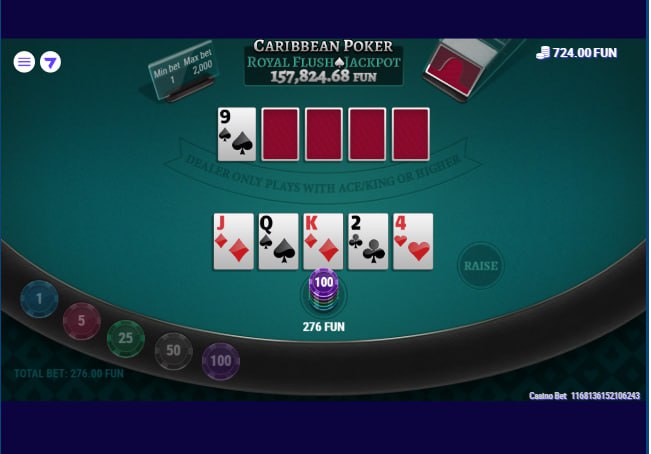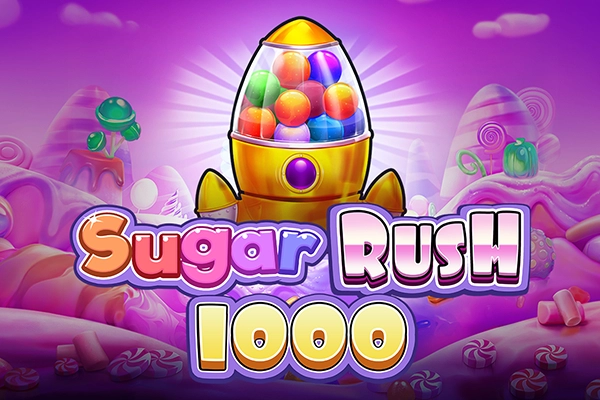Caribbean Poker Royal Flush Jackpot presents the popular casino card game variant in a digital format. This head-to-head poker style pits the player against a dealer, focusing on classic five-card hand comparisons. The main game requires players to place an Ante bet and then decide whether to Fold or Call after reviewing their hand against the dealer’s single visible card. Success in the primary game depends on outranking a dealer hand that meets minimum qualification criteria, typically Ace-King high. A significant additional element is an optional side bet linked to a progressive jackpot pool. Specific high-tier poker hands, such as a Royal Flush or Straight Flush, trigger payouts from this growing jackpot fund. The core game mechanics offer a theoretical return to player rate of 97.18% when the progressive jackpot contribution is not factored in. The game interface provides a direct, uncluttered representation of a poker table layout, keeping attention on the card action and jackpot total.
The landscape of online card games for entertainment includes a variety of poker adaptations, each offering a specific set of rules and player interactions. Among these is Caribbean Poker, a variant played not against other participants, but directly against the dealer. The version under review, titled “Caribbean Poker Royal Flush Jackpot,” distinguishes itself primarily through the incorporation of a linked progressive jackpot element tied to specific high-ranking hands, adding a distinct layer of excitement beyond the standard game payouts. This integration suggests an experience aiming to blend classic table game strategy with the allure of potentially significant, albeit rare, jackpot awards.
Players approaching this game are likely familiar with standard poker hand rankings and the fundamental goal of achieving a stronger hand than the dealer. However, the structure here diverges from communal card games or player-versus-player formats. The focus remains tightly on the individual confrontation between the player's five-card hand and the dealer's hand, with the player holding the advantage of seeing their full hand before the dealer reveals theirs (though the dealer's hand has a visible ‘up-card'). The core decision – to continue or fold – forms the strategic heart of each round. This particular implementation emphasizes a straightforward, uncluttered interface, keeping the focus firmly on the cards and the potential for that coveted progressive payout displayed prominently at the top of the screen. The inclusion of betting options like “Redo Bet” and “Reset Bet” points to design choices intended for ease and repetition, catering to players who appreciate efficient gameplay flow.

Core Gameplay Flow and Player Decisions
The process of playing a round in the Caribbean Poker Royal Flush Jackpot game is initiated by the player placing an Ante bet. This bet is mandatory to receive any cards. In addition to the Ante, players have the option to place a separate side bet specifically designated for the Progressive Jackpot. This optional wager activates participation in the jackpot payout structure, which is entirely independent of the standard game's outcome. The minimum and maximum limits for both the Ante and this optional bet are defined, although the exact values vary depending on the specific table limits configured. The provided information indicates these limits apply strictly to the Ante and the Optional (Jackpot) bet, while the subsequent Raise bet is fixed at precisely two times the placed Ante amount.
Once the player has placed their desired bets, the next step involves pressing the “Deal” button. This action triggers the distribution of five cards to the player, which are immediately displayed face up. Simultaneously, the dealer receives a five-card hand, but only one of their cards is revealed face up to the player. The remaining four dealer cards remain face down at this stage. This reveal presents the crucial juncture in the game. The player must evaluate the strength of their own five-card hand and weigh it against the information provided by the dealer's single visible card. Based on this assessment, the player has two possible actions: they can choose to “Fold” or to “Call.”
Selecting “Fold” means the player forfeits their initial Ante bet (and the optional Jackpot bet, if placed) and the round ends for them. No further cards are revealed, and no payouts from the main game occur. Choosing to “Call,” however, signifies the player's decision to continue the round and compete against the dealer. This requires the player to place an additional wager, the Raise bet, which as noted, is exactly double the initial Ante bet. Only after the player commits the Raise bet does the game proceed to the showdown phase. This straightforward decision point – continue or fold – is central to the strategy, forcing players to decide if their hand has sufficient strength to warrant the risk of the larger Call wager.
Understanding Dealer Qualification and Main Game Payouts
A fundamental rule that significantly impacts the outcome of any given round in Caribbean Poker is the requirement for the dealer's hand to “qualify.” According to the game's help information, the dealer's hand must contain at least an Ace and a King (Ace-King high, also noted as AK high) or better for the main game comparison and payouts to proceed fully. This is a critical detail; a strong player hand might not result in a payout if the dealer's hand fails to meet this minimum threshold.
If the dealer's hand does not qualify (i.e., it is weaker than AK high), the outcome for the player is relatively straightforward regardless of the player's hand strength. In this scenario, the player receives an even money payout (1:1) on their initial Ante bet. The Call bet, which the player placed to continue the round, is simply returned to the player – it results in neither a win nor a loss. This qualification rule effectively acts as a protection for the player when the dealer is dealt a particularly weak hand, ensuring the player at least recovers their initial wager if they chose to Call, plus a payout on the Ante.
However, if the dealer's hand does qualify (AK high or better), the round proceeds to a direct comparison of the player's hand versus the dealer's hand. Standard poker hand rankings, from High Card up to Royal Flush, determine the stronger hand.
The Allure of the Progressive Jackpot Side Bet
Beyond the standard player-versus-dealer payouts, the distinctive feature of this specific Caribbean Poker variant is the optional Progressive Jackpot side bet. This bet is entirely separate from the main game's outcome and paytable. Placing this small, optional wager per round activates the possibility of winning a portion or the entirety of the displayed progressive jackpot total. It's important to note that this is a side bet; winning a main game payout does not depend on placing the jackpot bet, and conversely, winning on the jackpot side bet does not require winning the main hand against the dealer. The side bet is resolved purely based on the rank of the player's five-card hand, regardless of whether the dealer qualifies or whether the player chooses to Call or Fold (though the images suggest the hand must be seen through the ‘Call' action or at least dealt after placing the bet to qualify for the side bet payout).
The progressive jackpot is not awarded for just any strong hand. It requires landing very specific, high-tier poker hands in the player's own five-card deal. The specific hands that trigger a jackpot payout on the side bet are listed clearly:
Royal Flush: Landing a Royal Flush (Ace, King, Queen, Jack, Ten of the same suit) pays out the full value of the displayed PROGRESSIVE JACKPOT. This is the ultimate goal of the side bet and accounts for the game's title.
Straight Flush: Achieving a Straight Flush (five cards in sequence, all of the same suit, but not a Royal Flush) pays a significant percentage of the jackpot: 10% of the PROGRESSIVE JACKPOT amount. This provides a substantial, albeit smaller, win than the full jackpot.
Four of a Kind: Landing Four cards of the same rank results in a payout from the side bet. While the exact monetary value for Four of a Kind and Full House payouts on the side bet were not fully visible in the provided images, the rules confirm these are fixed payout amounts (not percentages of the progressive pool).
Full House: A hand consisting of Three of a Kind and a Pair also triggers a payout on the side bet, again at a fixed monetary value.
This side bet structure creates two distinct payout paths in the game: the standard win against the dealer based on the fixed odds for the Call bet, and the potentially much larger, but far less frequent, wins from the jackpot side bet based on specific hand ranks. The fact that the jackpot pool is progressive means it grows over time as players across potentially multiple games contribute a small percentage of their bets to the shared pool. This dynamic is what drives the potentially life-changing sums displayed at the top of the interface, although hitting the required hands for these top-tier payouts remains highly improbable, inherent to the nature of progressive jackpots.
If you are trying to grasp the interplay between the main game payouts and the distinct triggers for the progressive side bet, or perhaps understand the precise values for the fixed payouts for Four of a Kind or Full House on the side bet, launching the Caribbean Poker Royal Flush Jackpot demo is a practical step. After starting the free demo slot or game, you can access the built-in help system by clicking the “i” icon, which provides the official, detailed rule breakdown and paytables directly from the game source.
Hand Ranking Specifics and Basic Strategic Consideration
The game adheres to standard poker hand rankings for comparing hands, as is typical for most casino poker variants. Understanding the hierarchy of hands is paramount to making informed decisions. The rankings, from highest to lowest, are:
Royal Flush (A, K, Q, J, 10 of the same suit)
Straight Flush (Five consecutive cards of the same suit)
Four of a Kind (Four cards of the same rank)
Full House (Three of a Kind and a Pair)
Flush (Any five cards of the same suit, not in sequence)
Straight (Five consecutive cards of different suits)
Three of a Kind (Three cards of the same rank)
Two Pair (Two different pairs)
One Pair (Two cards of the same rank)
High Card (No combination better than a single high card)
Within each category, higher-ranking cards determine the winning hand (e.g., three Kings beats three Queens). Suits hold no ranking value in this game, except when determining a Flush or Straight Flush. An Ace can function as the highest card in a sequence (A, K, Q, J, 10 for a Royal Flush or Straight) or the lowest card in a low straight (A, 2, 3, 4, 5). When comparing hands of the same rank, the highest ranking cards within the scoring combination decide the winner (e.g., King-high Straight beats a Queen-high Straight). If the scoring cards are identical (e.g., two players have A,A,K,Q,J), the rank of the remaining ‘kicker' cards is used to break the tie. This adherence to traditional rankings makes the game accessible to those with existing poker knowledge.
From a player perspective, the strategic decision lies in the Call or Fold choice after seeing their hand and the dealer's single up-card. While optimal strategy charts exist for Caribbean Stud Poker, the basic consideration revolves around the probability of having a hand strong enough to beat a qualifying dealer hand, given the information available. Folding with weak hands that are unlikely to improve or beat even a marginal dealer hand is generally the prudent decision, as it limits the loss to just the Ante and side bet. Calling, on the other hand, requires confidence in the player's hand to justify risking double the Ante. Experienced players understand that calling with marginal hands against certain dealer up-cards can be disadvantageous in the long run due to the dealer qualification rule and the structure of the payouts. The side bet is largely a matter of player preference and bankroll size, as its negative expected value over time contributes to the jackpot pool, but it offers the chance for payouts far exceeding those of the base game. Deciding whether to participate in the jackpot side bet is a separate consideration from the main game strategy, essentially a choice between accepting a higher variance pursuit for potentially enormous rewards or sticking to the standard game with its known RTP.
Game Presentation and User Interface Elements
Visually, the Caribbean Poker Royal Flush Jackpot game presents a clean and functional design centered around a digital representation of a poker table. The dominant color appears to be a classic casino green felt, providing a familiar backdrop for card play. Chip denominations (25, 50, 100 units are visible in the images) are clearly rendered, allowing players to visually confirm their selected bet size before placing wagers. The layout positions the player's hand area clearly below the community card space (though in this variant, community cards are not shared). The dealer's hand area is situated above, reinforcing the head-to-head nature of the game.
Control buttons are logically placed at the bottom of the screen. The prominent “Deal” button signals the start of card distribution. After the initial deal, this button likely changes to “Call” and “Fold” options, presenting the player's decision clearly. Additional controls for adjusting bet size are present, alongside the “Redo Bet” and “Reset Bet” functionalities mentioned in the rules – small quality-of-life features for players settling into a rhythm. The display for the PROGRESSIVE JACKPOT amount is a constant presence at the top, often highlighted and changing as contributions are made, serving as a persistent visual reminder of the game's main drawing point beyond standard poker payouts.
The graphical style appears solid and standard for digital table games – card symbols are crisp and easily identifiable, numbers on the chips are legible, and the overall aesthetic is one of straightforward simulation rather than elaborate thematic immersion. Animation, while not fully demonstrable in static images, would likely consist of smooth card dealing movements and clear visual indicators for hand comparisons and payouts. The “i” information button and potentially settings or game history icons are also present, providing access to rules, settings, and past results – essential features for players wishing to review gameplay details or learn more about the mechanics. While it may lack the elaborate visual effects or complex animations found in many modern slot machines, the presentation is functional and serves the purpose of clearly representing the classic table game experience with the added jackpot counter as a key focal element. This approach appeals to players who prioritize clarity and mechanics over flashy graphics, focusing instead on the strategic depth (or lack thereof, depending on the player's approach) and the jackpot chase.

Considering Developer Approach and Game Metrics
While the specific developer behind this “Caribbean Poker Royal Flush Jackpot” game isn't explicitly stated in the provided images, the existence of this particular iteration within a platform suggests a developer focused on providing classic casino experiences augmented with popular jackpot mechanics. The implementation of standard Caribbean Stud Poker rules with the progressive jackpot side bet indicates an understanding of what attracts players to both traditional card games and the potential for large, irregular wins. The clean interface and functional design point towards a development philosophy that prioritizes stability, clear presentation, and adherence to established game rules. The inclusion of features like Redo/Reset bets further suggests a focus on player convenience and efficient gameplay loops, which are valuable characteristics for online versions of repeated-action games.
Crucially, the game's information explicitly provides insights into its theoretical return profile. The document states the Theoretical Return to Player (RTP) excluding the PROGRESSIVE JACKPOT is 97.18%. This figure represents the average percentage of money wagered on the standard game (Ante and Call bets when applicable) that is expected to be returned to players over an extremely long period of play. An RTP of 97.18% is generally quite favorable for a casino table game when compared to many slot machines, indicating relatively good player value on the core game itself if the jackpot side bet is not placed.
The document then states that the Theoretical Return including the PROGRESSIVE JACKPOT is dependent on the size of the jackpot. This is a key analytical point. The standard RTP of 97.18% is calculated without factoring in the jackpot payouts, which are funded by contributions from the jackpot side bets. When the jackpot side bet is placed, a portion of that bet contributes to the jackpot pool, slightly reducing the RTP on the side bet itself compared to if all potential winnings were paid out immediately as fixed odds. The overall RTP including the jackpot side bet fluctuates. It will be lower than 97.18% when the jackpot is small (as the cost of the side bet outweighs the expected payout value from a small pool) and potentially rise significantly higher than 97.18% only when the jackpot grows to an exceptionally large size, at which point the long-shot possibility of hitting the massive jackpot statistically pulls the overall return upward. This is a critical aspect for experienced players who evaluate games based on expected value; the base game offers a solid return, while the jackpot side bet represents a high-variance gamble where the return varies drastically with the jackpot size. The legal note stating game outcomes are independent reassures players of fairness within the confines of probability, ensuring each deal is unrelated to previous ones.
Overall, this Caribbean Poker Royal Flush Jackpot game appears well-executed as a digital adaptation of the card game, particularly for players drawn to the head-to-head format and the potential for a large jackpot payoff. Its standard game RTP is competitive, and its presentation is clear and focused. It seems well-suited for experienced players who understand poker rankings and enjoy the specific strategic dynamic of Caribbean Stud, or those seeking a traditional casino card game experience online, perhaps testing the waters with free slots online versions before engaging in real-money play. The progressive jackpot side bet adds a distinct layer, appealing to the segment of the audience captivated by the possibility of a major windfall, accepting the lower base return on that specific wager for the chance at a large prize. Whether to engage with the side bet depends entirely on the individual player's risk tolerance and desire to chase the biggest possible win, separate from the fundamental skill and chance involved in playing the base poker hand itself. This game offers a specific kind of thrill – the classic card game combined with the potential for a massive jackpot that grows with player engagement across the network.













